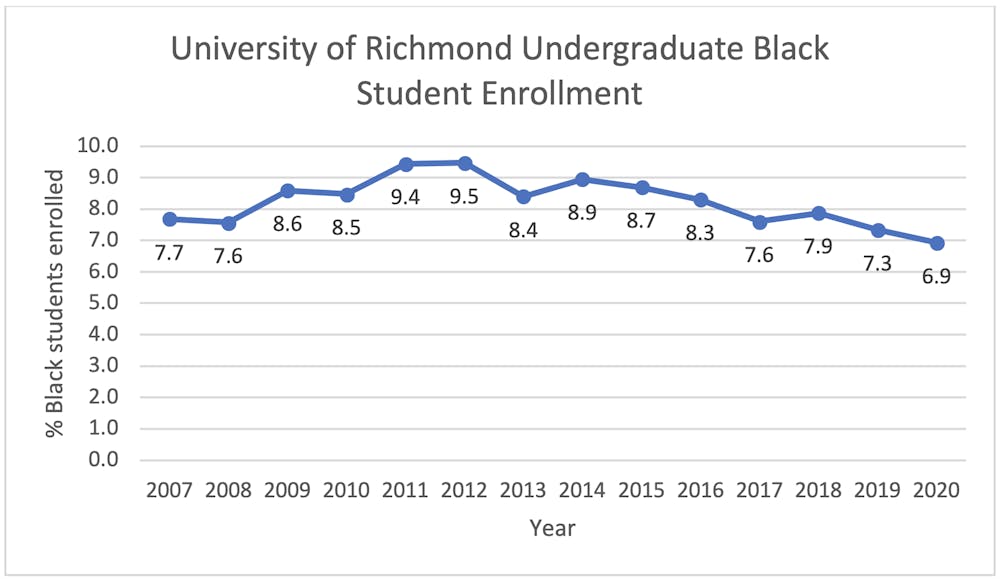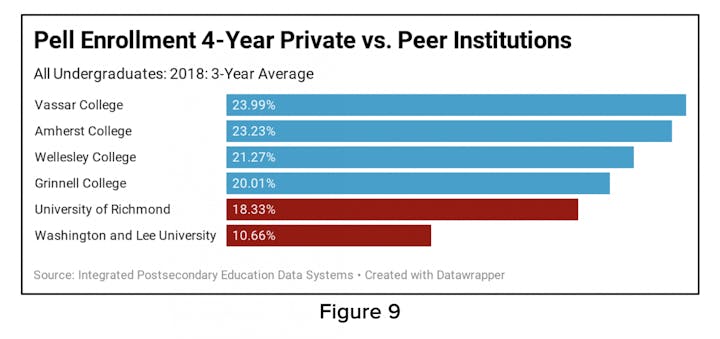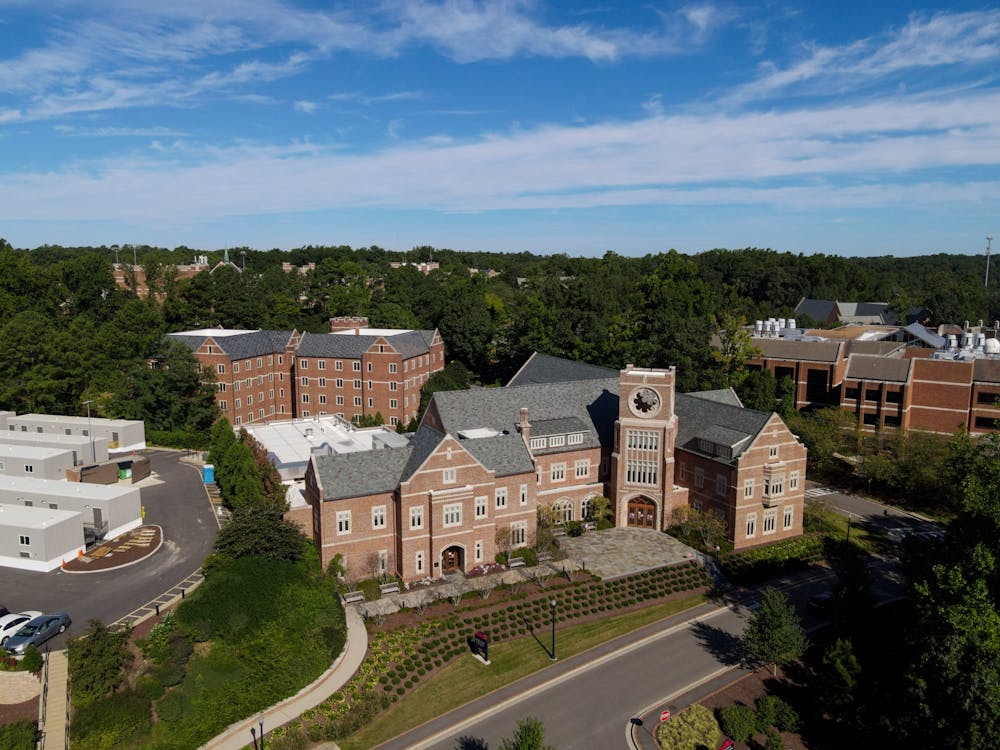Black and low-income student enrollment percentages at the University of Richmond decreased in 2020, according to data from the UR Fact Book.
Some members of UR and the local Richmond community said they were worried that the Board of Trustees' response to the Black Student Coalition’s demands would steepen this trend.
Following a decade of decline, Black student enrollment at UR totaled 232 in the fall of 2019 and decreased to 228 in 2020, according to UR Fact Books. The percentage of students enrolled who were eligible for Pell Grants – federal financial aid available to low-income families – decreased from 17% to 16% in 2020, according to the 2020-21 Fact Book.

A display of the declining percentage of Black student enrollment at the University of Richmond. Graph made by Olivia du Bois based on enrollment data in the University of Richmond Fact Book.
About 7% of students who enrolled at UR in the fall of 2020 identified as Black or African American, compared to 7% in fall 2019 and 8% in fall 2010, according to the UR Fact Book.
Declining enrollment numbers of Black students at UR reflect a state-wide disparity in Black and low-income student enrollment in higher education, according to research by Education Reform Now, a national, non-partisan think tank and advocacy group.
Over the last decade, Black student applications and acceptances to UR have increased by 30% and 46% respectively, said Stephanie Dupaul, vice president for enrollment management at UR. The decline in Black student enrollment is a question of yield, the percent of students admitted who choose to enroll, she said.
The Board’s initial decision not to rename Mitchell-Freeman and Ryland halls puts into question UR’s commitment to inclusivity and could adversely impact Black student recruitment and enrollment at UR, said Bernita Williams, the school counselor and testing coordinator at Richmond Community High School.
“I have always promoted University of Richmond, and I think it’s a great school. It provides a quality education,” Williams said. “However, in [light] of what has been going on, I have had some reluctancy to do that, to recommend the school.”
Some of Williams’s students brought up the renaming issue saying they would not want to attend UR, she said, but Williams did not know if the students had applied to UR.
Williams shared her new concerns about UR and how truly inclusive UR is with her high school students, but said she would not discourage students from applying. Campus-wide disaffiliation could also impact student enrollment regardless of race because campus activities play a large role in a student’s college decision, Williams said.
“I’m disappointed at [the renaming decision], because I always thought [UR] was a progressive school, and I see they’re not,” Williams said.
Enjoy what you're reading?
Signup for our newsletter
Dupaul said the high school counselors she worked with almost universally saw the current events on campus as a growing pain, but also recognized that former students who have attended UR have had amazing experiences and been successful.
“We’re in an uncomfortable place right now, admittedly,” Dupaul said. “We’re trying to have thoughtful conversations and recognize that there are a lot of different experiences on our campus.
“Not all of them live up to our expectations. And we absolutely acknowledge that, and it’s a regret for us, because we want to have a thriving and inclusive community. But we firmly believe the best way we can make this a better community is to bring students here who will help make this a better community.”
UR is not the only Virginia university struggling with low Black and low-income student enrollment. Education Reform Now released a briefing on April 15, the first in a series on a larger report on Virginia higher education, revealing similar statistics across the state.
The briefing found that of the 15 public U.S. colleges and universities that have the lowest working-class and low-income student enrollment, one-third are in Virginia.
Despite 34% of the state of Virginia’s 18- to 24-year-old population being Black or Hispanic, just three of the 15 public four-year institutions in the state match or surpass that percentage in their student population – two of the three being historically Black universities, according to the briefing.
The national average of higher education students who receive Pell Grants was 34% in 2018, according to the Integrated Postsecondary Education Data System. UR falls short of the national average, and it also enrolled Pell Grant recipients at a rate 24% lower than at peer institutions between 2016 and 2018, according to the briefing.
Peer institutions are other highly ranked national liberal arts colleges in the U.S. News & World Report best college rankings, said Katlyn Riggins, policy analyst at ERN and one of the briefing’s authors.

A graph including data about Pell Grant enrollment averages in 4-year private universities. Graph courtesy of Education Reform Now.
Twenty percent is the floor for an acceptable statistic for students enrolled at universities who receive Pell Grants, especially universities such as UR with a billion-dollar endowment, James Murphy, senior policy analyst at ERN and another of the briefing’s authors, said.
The city of Richmond’s population is 47% Black, while UR’s Black student population hovers around 7%, Riggins said. Considering that UR recruits students from all 50 states, UR should at least be representative of the U.S. in terms of diversity, Murphy said.
The U.S. population was 13.4% Black in 2019, according to U.S. census estimates, and Virginia’s population was 19.9% Black in 2019, according to census estimates.
“We want to see colleges making progress when it comes to diversity, and most especially when it’s easier for them to do so because they do have a lot of money,” Murphy said. “That gives them the power to do things that a smaller regional private college or a smaller regional public college may not have the resources to pursue – to achieve that progress.”
At the end of the 2017-18 fiscal year, UR had the 39th largest endowment of all degree-granting postsecondary institutions in the U.S. at a market value of $2.5 billion, according to IPEDS data. UR’s endowment currently stands at $2.4 billion, according to the UR website.
Recruitment, financial aid and campus climate are key to increasing Black and low-income student enrollment on college campuses, Murphy and Riggins said.
The University Faculty Senate formed an ad hoc Black student enrollment committee this semester that will be charged with reviewing admissions and recruiting practices, campus climate, social life, curricular issues and anything that has a significant impact on Black students at UR, Faculty Senate President Thad Williamson said.
The charges of the University of Richmond Faculty Senate ad hoc committee on Black student enrollment.
The committee formed on April 1 and will continue its work until April 1, 2022, according to a document Williamson sent to The Collegian. Its official charge is to identify policies and practices that will increase the application, yield and retention rates of Black undergraduate and graduate students at UR, according to the document.
“My preliminary assessment is that while we have done important work to build more diversity within the student body over the last 10 or 15 years, that the campus culture, social life, norms, all that are still at least in part contributing to a vision of the university as a predominantly white place, in which whiteness is the norm,” Williamson said. “So, I think the culture of the campus has to change in ways to catch up with the enrollment.
“If we can figure out how to make that happen, that’s going to change the place forever in a good way.”
In November 2020, UR announced a No Loan Program for Richmond Public School students. The program commits UR to meeting the full demonstrated financial need of all RPS students with grant aid rather than with loans.
RPS district high schools have 85% minority enrollment with a majority being Black students, Public School Review reported. In 2020, all schools in the RPS district had about 52% of students enrolled who were economically disadvantaged, the Virginia Department of Education reported.
UR faculty, staff and admissions officers have been working to build a more diverse, equitable and inclusive campus community, but “keep getting smacked back by mistakes in upper administration leadership,” said Mari Lee Mifsud, professor of rhetoric and women, gender, and sexuality studies, while comparing the process to a game of whack-a-mole.
Mifsud, who has worked at UR for nearly 24 years, is part of an informal group of faculty and staff that aims to improve UR’s commitment to diversity, equity and inclusion, she said.
The Board’s refusal to meet the demands of the BSC has not only created a crisis on campus, but it is setting up future attempts to build a diverse community to fail, Mifsud said.
Mifsud points to the No Loan Program as an example. While it is an effort to embrace the local Richmond community and bring in racially and socioeconomically diverse students, it is being set up to fail by the Board’s actions, she said. The Board’s actions could make prospective students from the RPS district turn away from UR, Mifsud said.
“We are in absolute crisis,” Mifsud said, “and the 23 years of work we’ve done, to me, is not just wiped away, but we’re back down in a deficit.”
Princeton University researchers found in a study published on April 20 that the reasons universities commit to diversity can result in disparities in academic achievement between white and Black students.
According to the Princeton study, moral rationales value diversity because of intrinsic values or principles such as the promotion of human dignity, whereas instrumental rationales value diversity as an asset to aid an organization in accomplishing routine objectives such as learning.
Researchers found that a balance between moral and instrumental rationales results in the least disparate outcomes, lead author of the study Jordan Starck said.
Institutional culture will change as a reflection of the type of commitment a university makes to valuing diversity, Starck said. If a university acts with fidelity to its diversity commitment, the rationale behind that commitment can affect how administration makes decisions on how to support students, resolve conflict, allocate resources and a number of other decisions to come in line with that commitment, he said.
The research findings suggest that institutions -- such as UR -- could better meet their diversity, equity and inclusion goals by evaluating and changing, if beneficial, their rationales for promoting diversity, the authors wrote.
Contact contributor Olivia du Bois at olivia.dubois@richmond.edu.
Support independent student media
You can make a tax-deductible donation by clicking the button below, which takes you to our secure PayPal account. The page is set up to receive contributions in whatever amount you designate. We look forward to using the money we raise to further our mission of providing honest and accurate information to students, faculty, staff, alumni and others in the general public.
Donate Now



